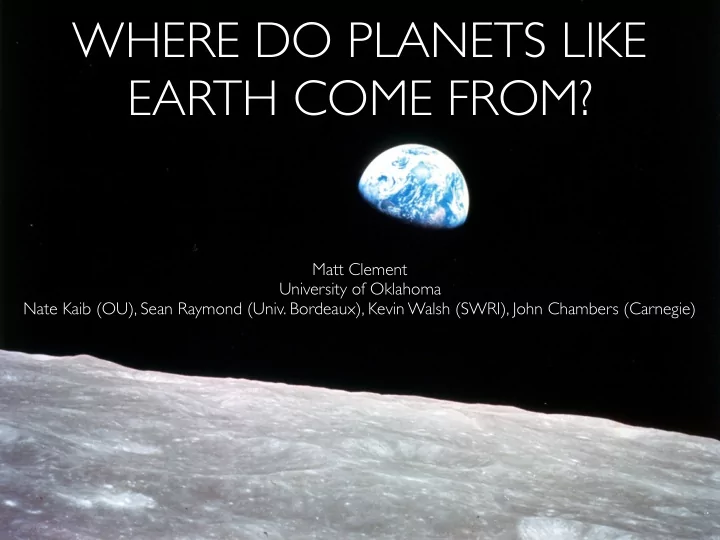

WHERE DO PLANETS LIKE EARTH COME FROM? Matt Clement University of Oklahoma Nate Kaib (OU), Sean Raymond (Univ. Bordeaux), Kevin Walsh (SWRI), John Chambers (Carnegie)
HOW DO PLANETS FORM? Stars form and collapse out of nebula of gas and dust Proto-Planetary disk of gas and dust t=0 (CAI) Small solid objects: “Planetesimals” (asteroid-like) t= Kyr-Myr? Aerodynamic Drag + Gravitational Focusing = Runaway Growth t=Myr Embryos + Planetesimals = Giant Impacts t=100s Myr Solar System
THE SOLAR SYSTEM Image Credits: NASA
BUT WHY SO DIVERSE? • Its complicated….. Image Credits: NASA
GAS GIANTS MUST FORM RAPIDLY • Within a few million years, while gas is still available. • Porto-Planetary disks only last <10 Myr (Haisch et al., 2001). • Isotopic dating indicates it took the Earth 50-150 Myr to form (Klein et al., 2009). • Terrestrial planets form out of the leftovers.
NEPTUNE URANUS TERRESTRIAL FORMING DISK JUPITER SATURN
HOW DO WE STUDY THIS NUMERICALLY? • 1000s of equal-mass planetesimals + 100s of equal-mass planet embryos. • Planetesimals don’t interact gravitationally with each other. • ~5 day timestep. • 200 Myr long simulations. • Speed up simulations by splitting Hamiltonian in to pure Keplerian component and an interaction component.
Asteroids Mars Earth Venus Mercury
Clement et al., 2018: ArXiv: 1804.04233
THESE STANDARD SIMULATIONS STRUGGLE TO: • Produce a small Mars: • Mars has just 10% the mass of the Earth. • Produce a depleted Asteroid Belt: • The entire belt has just a few percent of the Moon’s mass. • Replicate the low orbital inclinations and eccentricities of the actual terrestrial planets. Image Credit: NASA
Clement et al., 2018: ArXiv: 1804.04233
THESE STANDARD SIMULATIONS STRUGGLE TO: • Produce a small Mars: • Mars has just 10% the mass of the Earth. • Produce a depleted Asteroid Belt: • The entire belt has just a few percent of the Moon’s mass. • Replicate the low orbital inclinations and eccentricities of the actual terrestrial planets. Image Credit: NASA
Clement et al., 2018: ArXiv: 1804.04233
THESE STANDARD SIMULATIONS STRUGGLE TO: • Produce a small Mars: • Mars has just 10% the mass of the Earth. • Produce a depleted Asteroid Belt: • The entire belt has just a few percent of the Moon’s mass. • Replicate the low orbital inclinations and eccentricities of the actual terrestrial planets. Image Credit: NASA
COLLISIONAL FRAGMENTATION • Used Blue Waters to re-run simulations using a code which includes the effects of collisional fragmentation. • Systems more like the solar system in terms of: • Eccentricities and Inclinations of planets. • Planet Spacing (particularly Venus-Earth spacing). • More small bodies for longer = more dynamical friction. Image Credit: Clement et al., in prep
THESE STANDARD SIMULATIONS STRUGGLE TO: • Produce a small Mars: • Mars has just 10% the mass of the Earth. • Produce a depleted Asteroid Belt: • The entire belt has just a few percent of the Moon’s mass. • Replicate the low orbital inclinations and eccentricities of the actual terrestrial planets. Image Credit: NASA
INSUFFICIENT RESOLUTION TO STUDY THE BELT • Used a GPU code on Blue Waters: • 3000 Ceres-sized asteroids. • Fully self-gravitating. • Good match to the actual asteroid belt’s orbital structure and total mass.
INCLINATION DISTRIBUTION ACT UAL Wa lsh & Mo rb id e lli, 2011 BL UE WAT E RS Simula tio ns De ie nno e t a l., 2016
HOW REALISTIC ARE THE INITIAL CONDITIONS REALLY? • It is difficult to reproduce the masses of Mars and the asteroid belt in any model: • 10s of planet embryos initially in the region. • ~1/4 Mars mass. • ~160x the total present mass of the belt.
GROWING EMBRYOS WITH GPUS • Standard initial conditions derived • Our new simulations: from narrow annulus simulations • Fully model all collisions. (Kokuba & Ida, 1995,1998): • 5000 x particles. • Un-realistic Collisions. • Test multiple semi-major axes. • 3000 x Small Moon- Asteroid sized particles. • Include edge effects (one in one out). • Analytical conversations to • Include gas effects. other initial semi-major axes.
WHY BLUE WATERS • GPU acceleration. • Large demand of project. • Fellowship $$$. • Helpful NCSA staff: special thanks to Roland Haas.
CONCLUSIONS • An orbital instability between the giant planets can explain Mars’ small mass. • Accounting for collisional fragmentation provides a better match to the orbital excitation in the inner solar system. • The building blocks for Mars and the Asteroid Belt were likely much smaller than for Earth and Venus.
Questions?
Recommend
More recommend